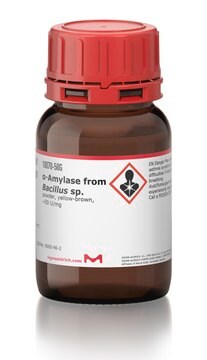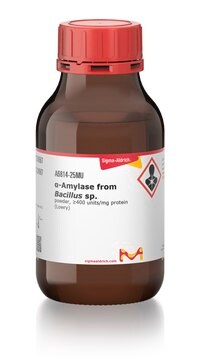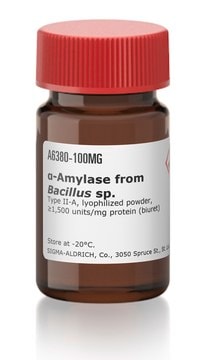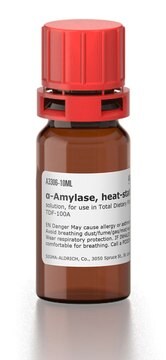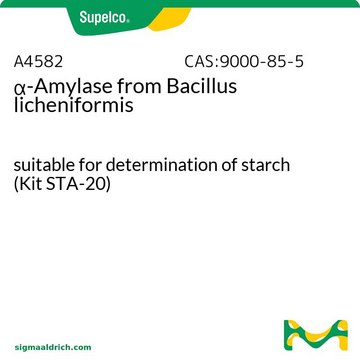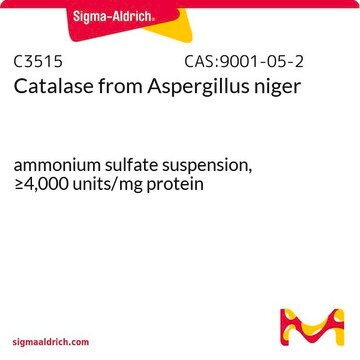10069
α-Amylase from Bacillus sp.
powder, yellow-brown, ~380 U/mg
Sign Into View Organizational & Contract Pricing
All Photos(2)
About This Item
Recommended Products
biological source
Bacillus sp.
Quality Level
form
powder
specific activity
~380 U/mg
greener alternative product characteristics
Waste Prevention
Design for Energy Efficiency
Learn more about the Principles of Green Chemistry.
sustainability
Greener Alternative Product
color
yellow-brown
greener alternative category
, Enabling
storage temp.
2-8°C
Looking for similar products? Visit Product Comparison Guide
General description
α-Amylase (α-1,4-glucan-4-glucanohydrolase) belongs to the glycosyl hydrolase family 13. The two aspartic residues and one glutamic acid residue are the prime catalytic residues of α-amylase. All amylases have three domain regions, namely, domain A with a central (β/α)8 barrel, domain B, and β-structure with a Greek key motif encompassing domain C.
We are committed to bringing you Greener Alternative Products, which adhere to one or more of The 12 Principles of Greener Chemistry. This product has been enhanced for energy efficiency and waste prevention when used in starch hydrolysis research. For more information see the article in biofiles.
Application
α-Amylase from Bacillus sp. has been used:
- as a dispersal enzyme to test degradation of S. aureus biofilms,
- in the enzymatic hydrolysis of tapioca starch
- in the enzymolysis of plant-based native and the amorphous granular starches
Biochem/physiol Actions
α-Amylase mediates the hydrolysis of starch, malto-oligosaccharides, and glycogen at the α-D-(1,4)-glucosidic linkages. Bacillus sp. serve as an important cell factory for the heterogeneous production of α-amylase. An extracellular secreted thermostable amylase from the Bacillus subtilis strain has also been reported.
Unit Definition
One unit is the amount of enzyme which liberates 1 μmole of maltose per minute at pH 6.9 and 25°C (using Cat. No. 85642 as substrate)
Other Notes
Heat stability of bacterial α-amylases; Action pattern on sweet potato starch, amylose and amylopectin; Action on native wheat starch.
Signal Word
Danger
Hazard Statements
Precautionary Statements
Hazard Classifications
Resp. Sens. 1
Storage Class Code
11 - Combustible Solids
WGK
WGK 1
Flash Point(F)
Not applicable
Flash Point(C)
Not applicable
Personal Protective Equipment
dust mask type N95 (US), Eyeshields, Gloves
Choose from one of the most recent versions:
Already Own This Product?
Find documentation for the products that you have recently purchased in the Document Library.
Customers Also Viewed
P Colonna et al.
Biotechnology and bioengineering, 31(9), 895-904 (1988-06-05)
Native starch granules from wheat have been subjected to enzymatic depolymerization with an alpha-amylase from Bacillus subtilis. Crystallites made from short-chain amylose and residues from mild acid hydrolysis have been also tested. Electron microscopy, particle size analysis, DSC, and x-ray
J.E. Anderson et al.
Journal of Food Science, 48, 1622-1622 (1983)
Masayuki Kagawa et al.
Journal of bacteriology, 185(23), 6981-6984 (2003-11-18)
The crystal structure of Bacillus subtilis alpha-amylase, in complex with the pseudotetrasaccharide inhibitor acarbose, revealed an hexasaccharide in the active site as a result of transglycosylation. After comparison with the known structure of the catalytic-site mutant complexed with the native
P.L. Chang Rupp et al.
Journal of Food Biochemistry, 12, 191-191 (1988)
Slavica Djonović et al.
PLoS pathogens, 9(3), e1003217-e1003217 (2013-03-19)
Pseudomonas aeruginosa strain PA14 is a multi-host pathogen that infects plants, nematodes, insects, and vertebrates. Many PA14 factors are required for virulence in more than one of these hosts. Noting that plants have a fundamentally different cellular architecture from animals
Our team of scientists has experience in all areas of research including Life Science, Material Science, Chemical Synthesis, Chromatography, Analytical and many others.
Contact Technical Service